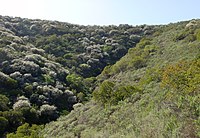
Back Aspekt (coğrafiya) Azerbaijani Експозиция (география) Bulgarian Exposition (Geographie) German جهت (جغرافیا) Persian Exposition (géographie) French ექსპოზიცია (ლანდშაფტი) Georgian Экспозиция склона Russian Bakı Turkish Ekspozitsiya (joylashuv) Uzbek
This article needs additional citations for verification. (May 2008) |

In physical geography and physical geology, aspect (also known as exposure)[1] is the compass direction or azimuth that a terrain surface faces.[2]
For example, a slope landform on the eastern edge of the Rockies toward the Great Plains is described as having an easterly aspect. A slope which falls down to a deep valley on its western side and a shallower one on its eastern side has a westerly aspect or is a west-facing slope. The direction a slope faces can affect the physical and biotic features of the slope, known as a slope effect.
The term aspect can also be used to describe a related distinct concept: the horizontal alignment of a coastline. Here, the aspect is the direction which the coastline is facing towards the sea. For example, a coastline with sea to the northeast (as in most of Queensland) has a northeasterly aspect.
Aspect is complemented by grade to characterize the surface gradient.
- ^ "Exposure | Meaning of Exposure by Lexico". Lexico Dictionaries | English. Archived from the original on February 13, 2020. Retrieved 2020-02-13.
- ^ National Wildfire Coordinating Group, Basic Land Navigation Archived June 26, 2013, at the Wayback Machine
© MMXXIII Rich X Search. We shall prevail. All rights reserved. Rich X Search